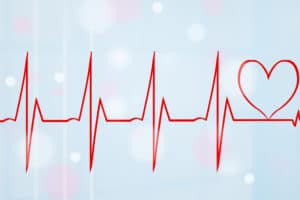 Atrial Fibrillation is a common condition where the heart beats irregularly and causes inefficient blood flow. Whether your doctor recently discussed your symptoms and diagnosis with you or you suspect you may have this arrhythmia, here are five things you may not be aware of when it comes to AFib and how it can affect you.
Atrial Fibrillation is a common condition where the heart beats irregularly and causes inefficient blood flow. Whether your doctor recently discussed your symptoms and diagnosis with you or you suspect you may have this arrhythmia, here are five things you may not be aware of when it comes to AFib and how it can affect you.
Anyone Could Have It
While it’s more common in people over 60, AFib can occur in anyone at any time and any age. According to the CDC, an estimated 2.7 to 6.1 million people in the United States have AFib. There are some factors that can increase your likelihood of developing the condition, such as obesity and diabetes, but regardless, it’s important to know the signs. If you feel an off-kilter fluttering in your chest, it may be time to get checked out by your doctor.
Alcohol and Caffeine Could Be a Factor
While unwinding is good for the soul, too much can be detrimental to the heart. According to AFibMatters.org, too much caffeine could raise one’s blood pressure and increase heart rate, triggering the condition. However, with moderation, even those diagnosed with AFib can enjoy two to three daily cups of coffee and an occasional drink as long as alcohol consumption is kept between two to three units a day. Two to three days a week should also be completely alcohol free.
AFib Increases Risk of Stroke
Because AFib causes the heart to beat irregularly, those who have the condition could potentially have blood pool in the atria since it’s not efficiently being pumped between ventricles. This means a blood clot could break off and lodge itself into the artery leading to the brain. According to The American Heart Association, 15-20 percent of stroke victims have AFib.
Knowing the symptoms of a stroke could save your life. The acronym BE FAST not only reminds us to act quickly, but to also be on the lookout for Balance problems, Eyes blurred, Face drooping, Arm weakness, Speech difficulties, and Time everything started.
There are Different Types of AFib
While the symptoms are the same, there are actually five different kinds of AFib that medical professionals use to classify patients. From the most mildest case being paroxysmal fibrillation with symptoms presenting only a few times a year, to long-standing AFib where symptoms last more than twelve months, talk with your doctor to classify your symptoms and find the best course of treatment.
It is Treatable
Fortunately, in many cases, AFib is treatable. There are medications to control the heart’s rhythm, blood thinners are often used to prevent clots from forming, surgery can make an impact, and a healthy lifestyle can often manage AFib risk factors.
UNC Health Appalachian is equipped with top-of-the-line facilities and services to treat cardiopulmonary patients within the High Country. The Heart & Vascular Center has AFib monitors and knowledgeable cardiologists who are able to help you manage this condition.
Have a question about how we can help you? Call The Heart & Vascular Center at (828) 264-9664.
Share this page
